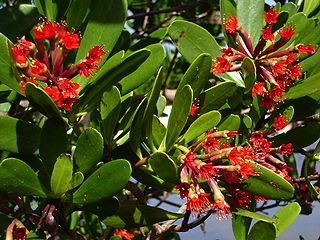
The Myrtales are an order of flowering plants placed as a sister to the eurosids II clade as of the publishing of the Eucalyptus grandis genome in June 2014.

Melastomataceae is a family of dicotyledonous flowering plants found mostly in the tropics comprising c. 175 genera and c. 5115 known species. Melastomes are annual or perennial herbs, shrubs, or small trees.

Dactylis is a genus of Eurasian and North African plants in the bluegrass subfamily within the grass family. They are known in English as cock's-foot or cocksfoot grasses, also sometimes as orchard grasses.
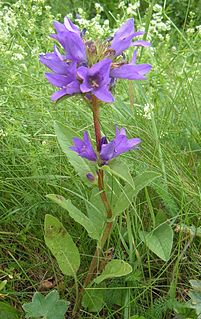
Campanula glomerata, known by the common names clustered bellflower or Dane's blood, is a species of flowering plant in the genus Campanula, belonging to the family Campanulaceae. It is the county flower of Rutland, England.

Melastoma affine, also known by the common names blue tongue or native lassiandra, is a shrub of the family Melastomataceae. Distributed in tropical and sub-tropical forests of India, South-east Asia and Australia, it is a plant of rainforest margins. Bees are the principal pollinators of this species.

Dactylis glomerata, also known as cock's-foot, orchard grass, or cat grass (due to its popularity for use with domestic cats) is a common species of grass in the genus Dactylis. It is a cool-season perennial C3 bunchgrass native throughout most of Europe, temperate Asia, and northern Africa.
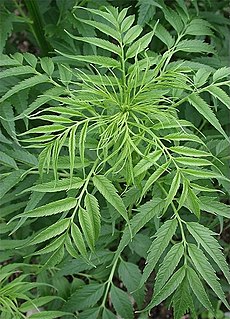
The Datiscaceae are a family of dicotyledonous plants, containing two species of the genus Datisca. Two other genera, Octomeles and Tetrameles, are now classified in the family Tetramelaceae.

Axinaea is a genus of flowering plants in the family Melastomataceae. As of 2012, there are at least 42 species. They are small trees and shrubs. They are native to the Americas; almost all are found in the Andes.
Knema glomerata is a species of plant in the family Myristicaceae. It is a tree found in Borneo, the Moluccas and the Philippines.
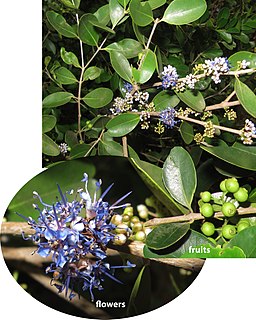
Memecylon is a plant group in Melastomataceae. It consists of 350-400 species of small to medium-sized trees and shrubs occurring in the Old World tropics. Memecylon is a monophyletic group basal to the Melastomataceae clade. Memecylon taxa have more than 600 published basionyms. Diversity of this group is concentrated in tropical Africa, Madagascar, Sri Lanka, India and Malaysia.

Meriania is a genus of flowering plants in the family Melastomataceae. There are about 93 species distributed from Mexico to Brazil and the Antilles.

Melastoma malabathricum, known also as Malabar melastome, Indian rhododendron, Singapore rhododendron, planter's rhododendron and senduduk, is a flowering plant in the family Melastomataceae. This plant is native to Indomalaya, Japan and Australia, and is usually found between 100 and 2,800 m on grasslands and sparse forests. It has been used as a medicinal plant in certain parts of the world, but has been declared a noxious weed in the United States. M. malabathricum is a known hyperaccumulator of aluminium, and as such can be used for phytoremediation.

Cotesia glomerata, the white butterfly parasite, is a small parasitic wasp species belonging to family Braconidae. It was first described by Carl Linnaeus in his 1758 publication 10th edition of Systema Naturae.

Rhexia virginica, the handsome Harry or Virginia meadow-beauty, is a species of flowering plant in the family Melastomataceae. It is native to much of eastern North America, and is often found in moist, often acidic soils in open areas.
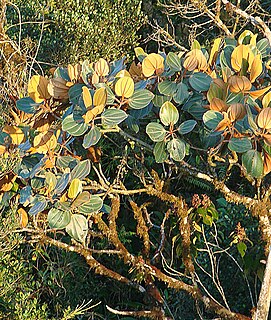
Graffenrieda is a genus of flowering plants in the family Melastomataceae. There are about 44 species. Most occur in South America. A few are distributed in Mexico, Central America and the Caribbean.

Pterolepis is a genus of flowering plant in the family Melastomataceae. Within Melastomataceae, it forms a clade with genus Pterogastra. Pterolepis contains some fifteen species, all of which are found in the Neotropical geographic realmm. Most species are concentrated in Brazil, with a few others across Central and South America.
Fritzschia is a genus of flowering plants in the family Melastomataceae, native to the Atlantic coastal forest of Brazil. They are sprawling or erect shrubs, with their branchlets and their hypanthia coated with either glandular or villose trichomes.

Cyrtandra heinrichii, known as ha'iwale or lava cyrtandra, is a perennial flowering plant in the family Gesneriaceae. It is found on the Hawaiian island of Kauai.

Myrciaria glomerata, commonly known as cabeludinha-vermelha or cabeluda-escarlate, is a species of plant in the family Myrtaceae. It is an evergreen shrub or small tree, endemic to the north and east of Brazil. Myrciaria glomerata has historically been used to incorrectly describe Myrciaria glazioviana.
Astronia is a genus of flowering plants belonging to the family Melastomataceae.

















